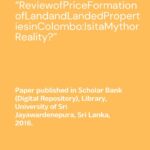
It’s high time to illuminate Murk in the Sri Lankan Real Estate Industry
January 19, 2025
Review of Price Formation of Land and Landed Properties in Colombo: Is it a Myth or Reality?
January 19, 2025Abstract
This study focus on a partition of undivided land among co-owners. Traditional land partition among co-owners often focuses on dividing the entire land into plots with equal extents. That leads to land plots with equal extents but dissimilar market values where some parties gain higher-valued land plots with more benefits whereas others get less-valued ones consequently each party may not be equally treated based on the value of the lots allocated to them. Simply the traditional practice focuses partition of land with an equal extent, not on equal values. By this study, a model is being introduced to address this issue of traditional land partition ensuring the co-owners involved are given land plots with equal values as against the value of the entirety and also ensure the sustainability of values. A case study in Homagama Pradeshiya Sabha Area was used for the development of the model where four co-owners were involved. The subject land was previously subdivided into four lots with similar extents. However, some of the owners were not satisfied with the way it has been subdivided claiming the subdivision was not reasonable. Hence, it was needed to subdivide the land with equal and sustainable market values. The methodology used in this study has several stages that flow from the collection of land-related data to the development of the model. The notional subdivision was done in order to find the total Market Value of the land using recent market evidence collected by a comprehensive market survey. Then the land was subdivided among four co-owners adapting per square foot rate and considering the cost of development, developers’ profit and the time value of money. MS Excel and AutoCAD software were used for analyzing data and developing the model. Accordingly, this already tested model suggests getting a valuer involved in land partition among co-owners to ensure the divided plots though at dissimilar extents are having equal values on an equitable basis.
Other Publications
A critical analysis of land tenure and property value
Authors: Download References Abstract This report refers to a valuation carried out in 2008 for a hotel located in the suburbs of Colombo intended for sale. […]Rising Above the Tsunami Waves
Authors: Information Rising Above the Tsunami Waves , Co-Author, Case studies of PTCRReMP’s Interventions, Post-tsunami Coastal Rehabilitation and Resource Management Programme by IFAD, 2013, Sri Lanka, […]Review of Price Formation of Land and Landed Properties in Colombo: Is it a Myth or Reality?
Authors: Download References Abstract Land and landed properties are fundamental ingredients for the socioeconomic development of a country. In any development project, land and buildings are […]


